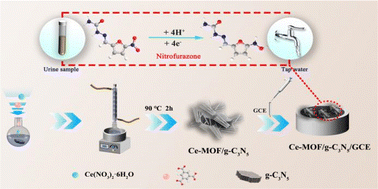An efficient electrochemical sensor based on the Ce-MOF/g-C3N5 composite for the detection of nitrofurazone†
Abstract
The Ce-MOF/g-C3N5 composite was first constructed using a simple reflux method in an oil bath. Herein, we report that the electrochemical sensor fabricated based on this composite exhibits high performance in the detection of nitrofurazone. Interestingly, this sensor exhibits an extra-wide linear range of detection composed of two line segments (7–100 μM and 100–2913 μM), as well as a low detection limit (LOD) of 6.15 μM (S/N = 3) under optimal experimental conditions. Additionally, the sensor demonstrates exceptional selectivity, reproducibility and stability. More importantly, the proposed electrochemical sensor can effectively monitor nitrofurazone in real samples such as urea and tap water, and obtain ideal recoveries. The sensor has such excellent performance because of the synergistic effect of the two components in the Ce-MOF/g-C3N5 composite. Compared with Ce-MOF, the introduction of g-C3N5 effectively not only enhances the conductivity of Ce-MOF/g-C3N5 but also exposes more active sites, which is conducive to increasing the electrocatalytic activity to reduce nitrofurazone. This research contributes new scientific research ideas for fabricating ideal electrochemical sensors based on g-C3N5 and MOFs.



 Please wait while we load your content...
Please wait while we load your content...